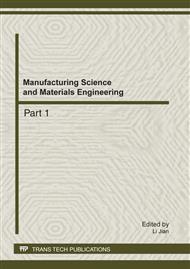p.366
p.371
p.377
p.383
p.389
p.395
p.401
p.408
p.412
The Research of Mica Pulp Concentration Detecting which Is Based on Laser with 650nm Wavelength
Abstract:
In order to solve the in-line inspection concerning mica-pulp which is in the state of lower concentration (0-6‰)& general concentration (1%-5%).And according to the photometric characteristics of absorption and scattering about mica-particles, we propose that the laser of wavelength (650nm) can be implemented the in-line inspection of concentration. Meanwhile, we gained the good effects regardless of whether adopted the theory of single scattering in the limit of lower concentration or use the theory of multiple scattering with respect to particle systems in the limit of general concentration. Thus, we can divide the inspection areas of concentration into linear zone (single scattering) & exponential region (multiple scattering) through the experiments data.Whereas, the precision of inspection can be up to 0.1‰ among the limit of lower concentration. Due to some phenomena anomalous scattering which its concentration only can be up to 6% in the certain condition of incident light. If adding intensity of light source which can increase the width of linear zone & exponential region, the valid region of inspection will be improved naturally. Thus, as for mica, the method of laser is extremely nice; its precision of inspection is high either.
Info:
Periodical:
Pages:
389-394
Citation:
Online since:
January 2012
Authors:
Keywords:
Price:
Сopyright:
© 2012 Trans Tech Publications Ltd. All Rights Reserved
Share:
Citation:


